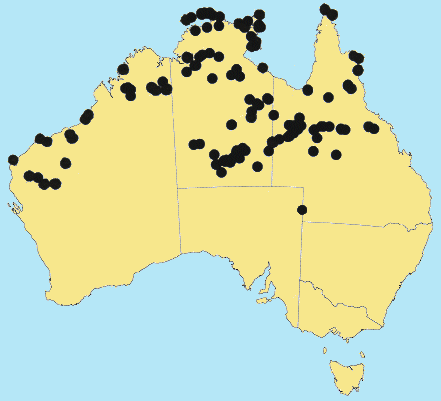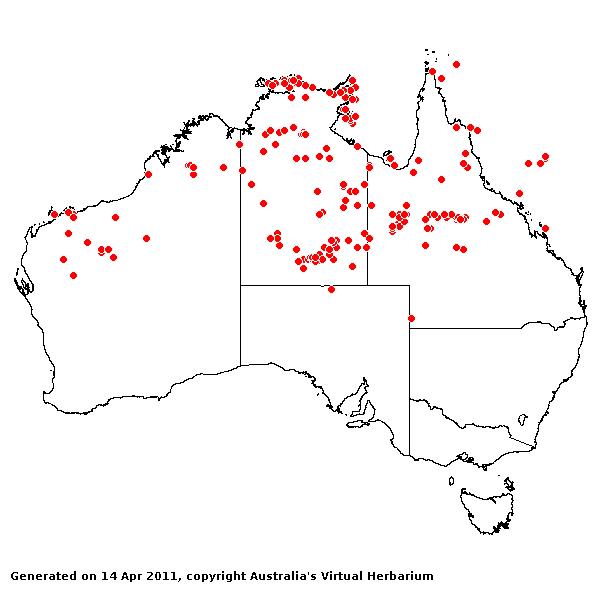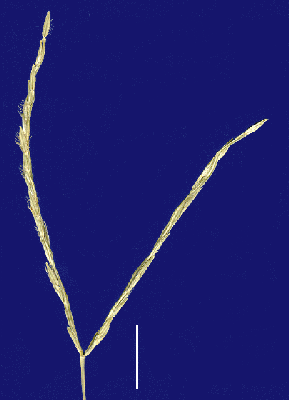Digitaria ctenantha (Muell.) D. K. Hughes. Bull. Misc. Inform. 310 (1923).
Classification. (GPWG 2001) : Subfamily Panicoideae. Paniceae.
Basionym and/or Replacement Name: Panicum ctenanthum F. Muell., Fragm. 8: 153 (1874).
Type of Basionym or Protologue Information: HT: F. Mueller s.n., Australia (K).
Recent synonyms: D. robusta.
Key references (books and floras): [1878] G.Bentham, Flora Australiensis 7 (469 as Panicum ctenanthum), [1952] C.A.Gardner, Flora of Western Australia 1 Gramineae (226), [1981] M.Lazarides in J.Jessop (ed)., Flora of Central Australia (474), [2002] D.Sharp & B.K.Simon, AusGrass, Grasses of Australia, [2006] J.Jessop, G.R.M.Dashorst, F.M.James, Grasses of South Australia (441).
Illustrations: [2006] J.Jessop, G.R.M.Dashorst, F.M.James, Grasses of South Australia (442, fig. 372).
Habit. Annual. Rhizomes absent. Stolons absent. Culms decumbent, 20–60 cm tall, 2–5 -noded. Mid-culm internodes glabrous. Mid-culm nodes glabrous. Lateral branches sparsely branched. Leaf-sheaths antrorsely scabrous, glabrous on surface or hairy. Leaf-sheath auricles absent. Ligule an eciliate membrane, 0.6–2 mm long. Leaf-blades linear or lanceolate, flat or conduplicate, 1.9–11 cm long, 2–5 mm wide. Leaf-blade surface scabrous, glabrous or indumented.
Inflorescence. Inflorescence digitate, with racemose branches. Racemes 2–3, spreading, 2.5–8.5 cm long, bearing 18–30 fertile spikelets on each.
Spikelets. Spikelets pedicelled, 2 in the cluster. Fertile spikelets 2-flowered, the lower floret barren (rarely male), the upper fertile, comprising 1 basal sterile florets, comprising 1 fertile floret(s), without rachilla extension, lanceolate, dorsally compressed, 3.6–5.5 mm long. Rhachilla internodes brief up to lowest fertile floret.
Glumes. Glumes thinner than fertile lemma. Lower glume ovate, membranous, 0 -nerved. Upper glume lanceolate, 2.7–3.8 mm long, membranous, without keels, 3 -nerved. Upper glume surface indumented. Florets. Basal sterile florets 1, barren, without significant palea. Lemma of lower sterile floret 100 % of length of spikelet, membranous, 7 -nerved.
Fertile lemma 3.3–5.4 mm long, without keel. Lemma apex muticous. Lodicules present.
Continental Distribution: Australasia.
Australian Distribution: Western Australia, Northern Territory, South Australia, Queensland, Cocos Keeling Is, Ashmore Reef, Coral Sea Is.
Western Australia: Gardner, Fitzgerald. Fortescue. Northern Territory: Darwin & Gulf, Victoria River, Barkly Tableland, Central Australia North, Central Australia South. South Australia: Lake Eyre, Eyre Peninsula. Queensland: Burke, Cook, Gregory North, Mitchell, South Kennedy, North Kennedy.
Notes. A transitional species between D. heterantha of the section Heteranthae and D. bicornis of the section Digitaria. Spikelet pubescence and nervation of the lower lemma is highly variable.
In tropical and subtropical sub-humid woodlands, arid and semi-arid low woodlands, acacia shrublands, arid tussock grasslands, coastal grasslands, and tropical sub-humid grasslands. Flowers mostly Feb.-May.






